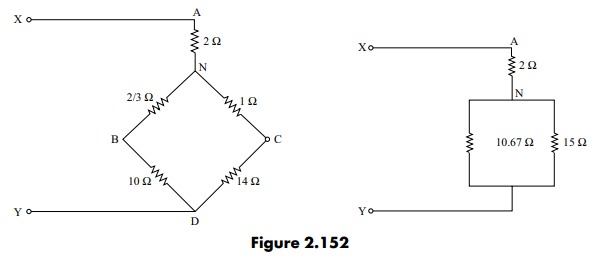Question 2.45: Find the resistance between terminal XY of the bridge circui......
Find the resistance between terminal XY of the bridge circuit shown in Fig. 2.150, by using delta–star conversion.

Step-by-Step
The 'Blue Check Mark' means that this solution was answered by an expert.
Learn more on how do we answer questions.
Learn more on how do we answer questions.
Let us change the resistances forming a delta across terminals A, B, and C into equivalent star.
\mathrm{R}_{\mathrm{A}}=\frac{\mathrm{R}_{\mathrm{AB}} \times \mathrm{R}_{\mathrm{AC}}}{\mathrm{R}_{\mathrm{AB}}+\mathrm{R}_{\mathrm{BC}}+\mathrm{R}_{\mathrm{AC}}}=\frac{4 \times 6}{4+6+2}=\frac{24}{12}=2 \Omega\\ \begin{aligned} & \mathrm{R}_{\mathrm{B}}=\frac{\mathrm{R}_{\mathrm{AB}} \times \mathrm{R}_{\mathrm{BC}}}{\mathrm{R}_{\mathrm{AB}}+\mathrm{R}_{\mathrm{BC}}+\mathrm{R}_{\mathrm{AC}}}=\frac{4 \times 2}{12}=\frac{2}{3} \Omega \\ & \mathrm{R}_{\mathrm{C}}=\frac{\mathrm{R}_{\mathrm{BC}} \times \mathrm{R}_{\mathrm{AC}}}{\mathrm{R}_{\mathrm{AB}}+\mathrm{R}_{\mathrm{BC}}+\mathrm{R}_{\mathrm{AC}}}=\frac{2 \times 6}{12}=1 \Omega \end{aligned}The equivalent star–forming resistances are
By replacing the delta resistance into equivalent star resistance, the circuit is drawn as in Fig. 2.152
The resistances of the two parallel paths between N and D are 1+14=15 \Omega \text { and } \frac{2}{3}+10=\frac{32}{3} \Omega, respectively.
Total Resistance Network Terminal X and Y
=2+\frac{15 \times 10.67}{15+10.67}=8.23 \Omega

Related Answered Questions
Question: 2.54
Verified Answer:
When the capacitor is fully charged, no current wi...
Question: 2.53
Verified Answer:
R=5.45 \times 10^6 \Omega, \quad C=1 \times...
Question: 2.52
Verified Answer:
We have,
\begin{aligned} i & =I_0\left(...
Question: 2.51
Verified Answer:
For the rise in current
i=\frac{V}{R}\left(...
Question: 2.50
Verified Answer:
Applying KCL, we can write
8=I_1+I_2[/latex...
Question: 2.49
Verified Answer:
We have shown the current directions in the variou...
Question: 2.48
Verified Answer:
Let V_A\ and\ V_B be the potential ...
Question: 2.47
Verified Answer:
Let V_A\ and\ V_B be the potentials...
Question: 2.46
Verified Answer:
We convert the delta forming resistances between t...
Question: 2.44